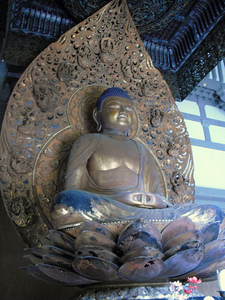Difference between revisions of "Jocho"
(some expansion) |
m |
||
| Line 16: | Line 16: | ||
Jôchô died in [[1057]] and is buried in [[Jobonrendaiji|Jôbon-rendai-ji]] in northern Kyoto. His tombstone is inscribed with the name Jôchô written in different characters than normally used to write his name (常朝 instead of 定朝); this alternate form of his name was granted him by the Imperial Court. | Jôchô died in [[1057]] and is buried in [[Jobonrendaiji|Jôbon-rendai-ji]] in northern Kyoto. His tombstone is inscribed with the name Jôchô written in different characters than normally used to write his name (常朝 instead of 定朝); this alternate form of his name was granted him by the Imperial Court. | ||
| − | His son [[Kakujo|Kakujô]] founded a studio on Shichijô, while Jôchô's disciple [[Chosei|Chôsei]] created his studio on Sanjô. Kakujo was then followed by his sons [[Raijo|Raijô]] and [[Injo|Injô]], who were in turn followed by Raijô's son [[Kojo|Kôjô]], and Kôjô's son [[Kokei|Kôkei]], who, along with his son [[Unkei]] and disciples [[Kaikei]] and [[Jokei|Jôkei]] formed the core of the [[Kei school]] and of [[Kamakura period]] Buddhist sculpture; thus, it can be seen that Jôchô's influence and impact was quite extensive and long-lasting, and integral to the Kei school's own style. | + | His son [[Kakujo|Kakujô]] founded a studio on Shichijô, while Jôchô's disciple [[Chosei|Chôsei]] created his studio on Sanjô. Kakujo was then followed by his sons [[Raijo|Raijô]] and [[Injo|Injô]], who were in turn followed by Raijô's son [[Kojo|Kôjô]], and Kôjô's son [[Kokei|Kôkei]], who, along with his son [[Unkei]] and disciples [[Kaikei]] and [[Jokei (sculptor)|Jôkei]] formed the core of the [[Kei school]] and of [[Kamakura period]] Buddhist sculpture; thus, it can be seen that Jôchô's influence and impact was quite extensive and long-lasting, and integral to the Kei school's own style. |
==References== | ==References== | ||
Latest revision as of 23:24, 2 February 2014
- Died: 1057/11/1
- Other Names: 康城 (Kôjô), 常朝 (Jôchô)
- Japanese: 定朝 (Jouchou)
Jôchô was a sculptor of Buddhist images, and is today widely considered one of the most famous Buddhist sculptors (busshi) in Japanese history. Known chiefly for having headed the design and creation of the Amida sculpture in the Byôdô-in, he established a new canon of style and proportion which would have a profound impact on Buddhist sculpture from that time onwards.
Though the year of Jôchô's birth is unknown, it is believed that his reputation must have been well-established by 1020, because he was commissioned at that time by Fujiwara no Michinaga to produce a number of sculptures for the Hôjôji. Jôchô was then granted the title of Hôkkyô (法橋), a prestigious Buddhist rank rarely granted to sculptors, in 1022. He would later be promoted to the rank of Hôgen (法眼), after producing a number of works for Kôfuku-ji in Nara, in 1048. Jôchô played a revolutionary role in achieving prestige and social status for sculptors, eventually rising to the rank of sôgô (僧綱), the first sculptor to do so.
Taking the tonsure and entering Jôbonrendai-ji in Kyoto as a monk, he changed his name to Kôjô (康城) and established a sub-temple, Shômeiin, with 12 monks.
Sadly, no works from his earlier period survive.
Created around 1053, the Amida at the Byôdô-in in Uji, a National Treasure, is easily his most famous work, and one of the most famous statues in the country. In addition to being done in yosegi zukuri (multiple-block construction) at a time when ichiboku zukuri (single-block construction) was still quite popular, this work represents new elements of style and proportion which countless later works would reference or emulate, and which create a greater feeling of calmness and stability than earlier forms.
Jôchô died in 1057 and is buried in Jôbon-rendai-ji in northern Kyoto. His tombstone is inscribed with the name Jôchô written in different characters than normally used to write his name (常朝 instead of 定朝); this alternate form of his name was granted him by the Imperial Court.
His son Kakujô founded a studio on Shichijô, while Jôchô's disciple Chôsei created his studio on Sanjô. Kakujo was then followed by his sons Raijô and Injô, who were in turn followed by Raijô's son Kôjô, and Kôjô's son Kôkei, who, along with his son Unkei and disciples Kaikei and Jôkei formed the core of the Kei school and of Kamakura period Buddhist sculpture; thus, it can be seen that Jôchô's influence and impact was quite extensive and long-lasting, and integral to the Kei school's own style.
References
- Plaque onsite at Jôchô's grave at Jôbon Rendaiji, in Kyoto.
- Mason, Penelope. History of Japanese Art. Second Edition. Upper Saddle River, NJ: Pearson Prentice Hall, 2005. pp144-145, 188-190.
- Paine, Robert Treat and Alexander Soper. The Art and Architecture of Japan. Third Edition. Yale University Press, 1981. p93.
